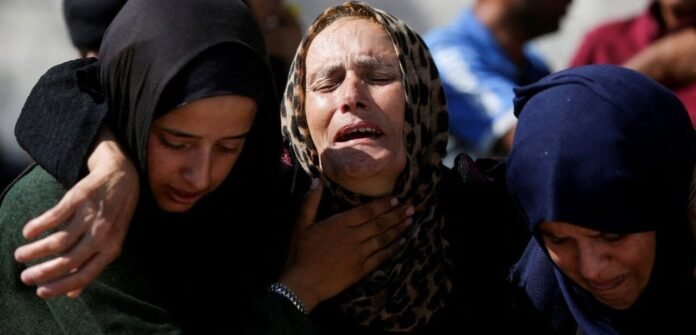Children among 94 Palestinians killed, 45 gunned down or bombed while waiting for food aid.
Another dark chapter unfolded in Gaza as Israeli airstrikes and gunfire killed 94 Palestinians over two days—45 of them while desperately seeking food aid, local hospitals and officials confirmed Thursday.
Among the dead are dozens of children, entire families, and victims who were simply sleeping or queuing for humanitarian assistance when death rained down. Grief choked the hallways of Gaza’s overstretched hospitals, where morgues overflowed and parents clung to the bodies of their babies.
At Nasser Hospital in Khan Younis, Intisar Abu Assi collapsed in anguish over the bodies of her son, daughters, and young grandchildren—all killed in a night-time airstrike that hit a tent camp. Survivors said families were asleep when the missiles struck. At least 13 people from one family died—six of them under the age of 12.
In central Gaza, 6-year-old Heba Abu Etiwi was killed near a falafel stand. Her brother caressed her face as she lay wrapped in a hospital morgue blanket. Eight died in that single strike Wednesday evening.
Elsewhere, 15 civilians seeking shelter inside a school in Gaza City were killed when a separate Israeli airstrike slammed into the building.
But it’s the bloodshed at aid distribution sites that has sparked global fury.
Hospital officials say five people were killed on roads leading to food sites operated by the Gaza Humanitarian Foundation (GHF)—a controversial, secretive U.S.-Israeli initiative set up to manage food distribution. In addition, another 40 Palestinians were shot or bombed while waiting for U.N. aid trucks at various locations across the besieged enclave.
Eyewitnesses claim Israeli troops regularly fire into the crowds that gather near GHF or U.N. aid sites, including so-called “military zones.” More than 500 Palestinians have died at these aid lines since the GHF programme began in May, with hundreds more wounded.
The Israeli military insists it uses only warning shots to disperse unruly crowds or those approaching soldiers, but survivors and rights groups say the scale and nature of the casualties suggest otherwise.
The GHF sites are guarded by armed American contractors, and the roads leading to them are patrolled by Israeli troops. Chaos and fear rule, say locals, who describe food distributions as “ambushes in disguise.”
On Thursday, Amnesty International accused Israel of using starvation as a weapon of war. In a blistering report, it labelled the GHF system a “booby trap for desperate, starved Palestinians.”
“By maintaining a deadly, dehumanising and ineffective militarised ‘aid’ scheme, Israeli authorities have turned hunger into a death sentence,” the report stated. The rights watchdog added that the GHF was little more than a PR cover to “placate international concern”, while U.N. food deliveries remain minimal due to Israeli restrictions.
While the international community continues to urge restraint, the facts on the ground remain grim. Civilians are being killed while doing nothing more than queuing for bread—their blood soaking into the sand as the world watches on.
With no ceasefire in sight and diplomacy stalling, the cost is being measured in children’s lives and mass graves. For Gaza’s residents, aid has become a lottery—and the prize may be death.
